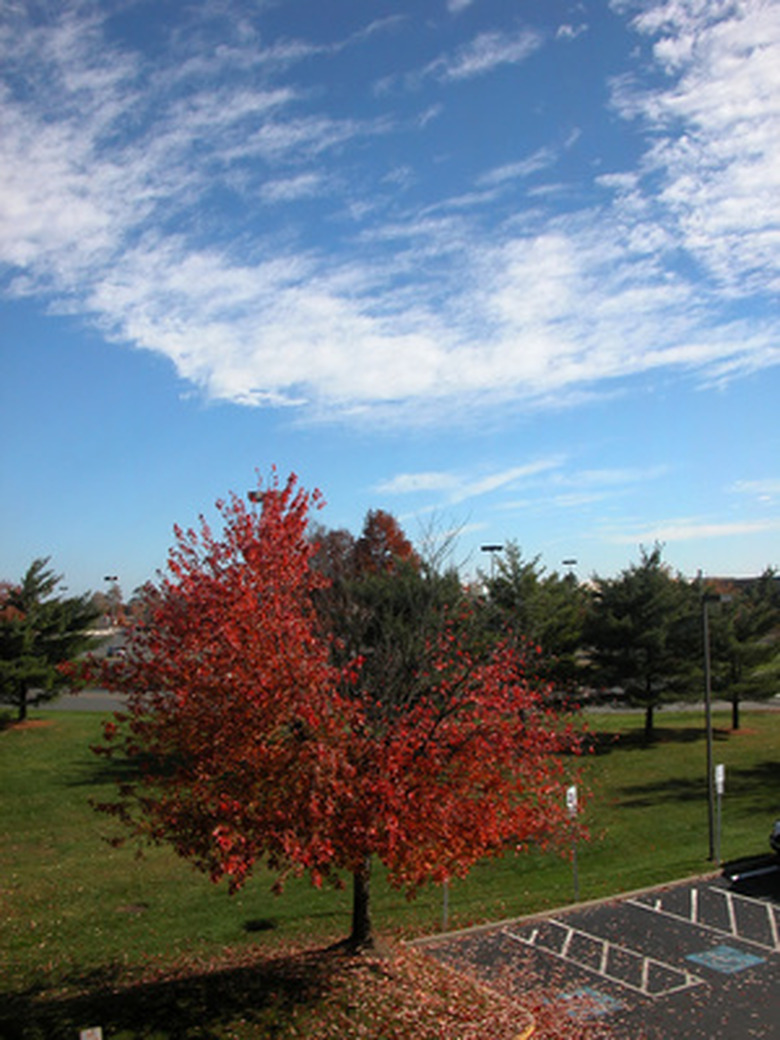How To Prune A Red Maple Tree
Red maple trees (Acer rubrum Linnaeus) feature vivid red foliage in the fall; for this reason, they're popular landscape trees. Red maple trees benefit from annual pruning to remove unhealthy wood and shape the tree. Maple trees can bleed when pruned in the early spring; while this doesn't harm the tree, it can create a sticky mess. To avoid the messy bleeding, prune your red maple tree in the late spring after leaves have developed.
Step 1
Check for dead, damaged and diseased branches on your red maple tree. Diseased and damaged branches have wounds, lesions, discoloration or scarring. Deadwood feels brittle. This wood needs to be removed for the health of the tree.
- Red maple trees (Acer rubrum Linnaeus) feature vivid red foliage in the fall; for this reason, they're popular landscape trees.
- Red maple trees benefit from annual pruning to remove unhealthy wood and shape the tree.
Step 2
Prepare a sanitizing solution of 1 part bleach to 10 parts water. Place your pruning tools in the bucket. Remove all the deadwood and unhealthy wood by cutting it off at the base or pruning back to a healthy branching intersection. In between each cut, sanitize your tools by dipping them in the bleach solution; this prevents spreading disease through the tree.
Step 3
Trim off any low-growing branches that impede movement under the tree, as well as any branches that grow downward.
Step 4
Head back long limbs on your red maple tree. Cut them back to a Y-intersection or a swollen tissue node.
- Prepare a sanitizing solution of 1 part bleach to 10 parts water.
- Remove all the deadwood and unhealthy wood by cutting it off at the base or pruning back to a healthy branching intersection.
Step 5
Remove crossed branches from the tree canopy and branches that grow vertically. This increases air circulation and prevents wood damage from the friction of the crossed branches.
Maple Tree Look Like After It Is Pruned?
Japanese maple (Acer palmatum) cultivars are most likely to need pruning to maintain a desirable shape. Young trees, especially those less than 15 years old, are prone to growing skinny, unattractive branches. Don't prune to restrict the height of the tree, but rather to encourage safe and attractive shapes. Never prune more than one-fifth of the crown or any branches more than half the diameter of the parent stem. The big leaf maple (Acer macrophyllum) is native along the West Coast and found in USDA zones 7 through 10. This tree in its best form is also oval, with a narrow crown and tight branches. Slices inside of the branch collar will open the tree to disease and it will have a difficult time sealing the wound. Use sharp, clean tools to avoid rips and tears in the bark. Rinse them, and allow them to air dry.
- Remove crossed branches from the tree canopy and branches that grow vertically.
- This increases air circulation and prevents wood damage from the friction of the crossed branches.
Things Needed
- Anvil pruners
- Lopping shears
- Hand saw
- Bleach
- Water
- Bucket
Tip
Saw large limbs with a handsaw. Cut small wood with anvil pruners and growth thicker than 3/4 inch in diameter with lopping shears.
References
- University of Missouri: Pruning and Care of Shade Trees
- Fine Gardening: Pruning Japanese Maples
- Arbor Day Foundation: Maple, Red Acer Rubrum
- Arbor Day Foundation: Maple, Sugar Acer Saccharum
- Arbor Day Foudation: Maple, Silver Acer Saccharinum
- ProArbor: 7 Things You Should Never Do When Trimming Trees
- North Carolina State University Cooperative Extension: Acer Palmatum
- Oregon State University: Bigleaf Maple (Acer Macrpphylum)
- University of Florida IFAS Extension: Disinfecting Pruning Tools
